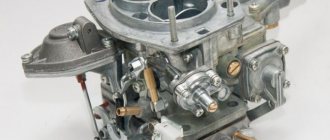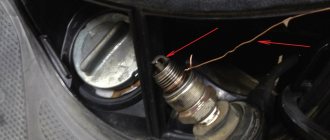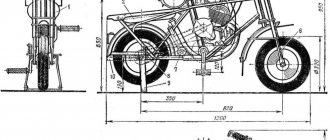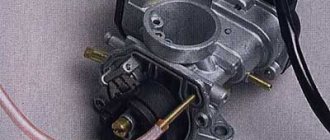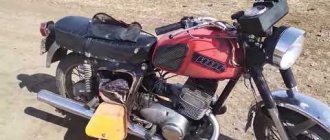One of the most popular two-wheeled vehicles in the world is, of course, the scooter! Many people start with them, since this type of motorcycle is characterized by simple operation and an affordable price. But, as a rule, beginners have no experience in repair and maintenance. In this article we will help you figure out what to do if your scooter does not start. Let's look at standard faults that make the scooter difficult to start. The most important thing in troubleshooting is to learn to recognize it by certain signs and proceed from simple to complex. Sometimes the reason is the most banal - the gas ran out, the battery was discharged, they forgot to turn on the power button or open the gas tap (on a moped). If these conditions are met, but the scooter still doesn’t start, we dig deeper.
Main reasons
So, let’s look at why the 4t scooter won’t start – the reasons can be roughly divided into the following categories:
- fuel system malfunctions
- ignition system malfunctions
- piston group malfunctions
- malfunction of the gas distribution mechanism (GRM).
Each of these 4 categories has its own several possible causes. When diagnosing a scooter, you should carefully pay attention to each category and the problem in it. Step by step, eliminating faults, you will definitely find the cause. And then it’s a matter of technology!
Advice! Remember that there may be several reasons. Therefore, having eliminated one breakdown, you should still check the serviceability of other devices from the list of possible faults.
Fuel system malfunctions
If there is no gasoline in the tank, the scooter will not start - everyone knows. The same situation occurs when the fuel system malfunctions - gasoline does not reach the combustion chamber. The consequence is that there is nothing to burn, so the engine does not start. The reasons may be as follows:
- faulty fuel valve
- clogged fuel filter
- contaminated carburetor, failure of its individual parts
- The vacuum suction supplied to the fuel tap does not work.
Tap
It is recommended to start repairs with the simplest ones. In this case, the diagnosis begins with the fuel tap (if there is gasoline in the tank). To check operation, remove the fuel supply hose from the carburetor, then crank the engine with the starter or crank. The serviceability of the tap will be visible by the stream of gasoline flowing from the hose.
The first thing you need to do is make sure there is gasoline in the fuel tank by opening the gas tank cap and looking inside
To make sure that the fuel tap of the scooter is working properly, you should disconnect the gasoline supply hose from the carburetor and, after cranking the engine, make sure that gasoline is flowing from the hose in a stream (observe fire safety measures!)
A constant flow of fuel, even when the engine is stopped, or a lack of fuel supply through the hose indicates a breakdown of the fuel valve. If fuel is constantly leaking, change the valve immediately. Otherwise, you should pay attention to the condition of the fuel hoses, and only then replace the fuel tap.
Filter
The serviceability of the filter is diagnosed visually and by blowing. A dirty filter should be replaced immediately. If the filter looks clean, but does not blow in the desired direction, it means it is clogged and requires replacement.
Carburetor
A dirty carburetor is another reason why fuel does not reach the combustion chamber. The device becomes dirty due to poor filters (fuel and air) and poor fuel quality. Here is a list of actions necessary to eliminate carburetor malfunction:
- remove the carburetor and disassemble it
- rinse and blow out the holes with compressed air (if compressed air is not available, use a regular pump)
- pay attention to the condition of the float chamber, both the float itself and its adjustment; condition of the locking needle - is it worn out or sunk?
- Clean the fuel nozzle thoroughly.
Remember! There are no small details in carburetor repair! One missed moment may cost you to clean the entire carburetor again and find out the cause.
Ignition system malfunctions
Another possible reason why the engine does not work is a malfunction of the ignition system. This group includes many different little things, each of which can become the main reason for the engine not starting.
- dirty or faulty spark plug
- high voltage wire
- ignition coil
- faulty ignition sensor
- failed switch.
Spark plug
Let's start our search again with the simplest thing. Unscrew the spark plug from the cylinder, put a cap on it and lean the electrodes against the cylinder. Next, rotate the engine with the starter. In this case, a spark should jump between the two electrodes of the spark plug - straight and curved. If it is missing, you should perform a number of actions:
- Clean the spark plug from carbon deposits and oil contaminants using a rag and a metal brush
- warm the candle on the fire of a gas burner
- set the optimal gap between the electrodes - the gap should be about 1-1.5 mm.
After completing these steps, check for spark again. If it appears, then you can try to start the engine. If there is no spark, replace the spark plug with a new one. If there is no spark on the new spark plug, you should pay attention to deeper problems.
To check the spark in the spark plug, lean it against the metal frame (engine) and turn the engine
High voltage wire
The most common problem with a wire is its exposure in a certain place (broken wire). A working wire should spark off the cylinder body or other metal part of the engine when the tip is removed.
If it’s not scary, you can check for voltage with your finger, but it’s better to rest it against the engine. A broken wire will conduct electricity at the break point without reaching the spark plug. The exposed area should be insulated or the wire replaced with a new one.
You can check the high-voltage wire using a special indicator screwdriver
Ignition coil
To test the ignition coil, you need a device for measuring electrical quantities - a multimeter. Disconnect the coil from the scooter: remove the tip of the wire from the spark plug, unscrew the bolt securing the coil and disconnect its contacts.
Using a multimeter, measure the resistance at the coil contacts. Also measure the resistance between the contacts and the spark plug output. The optimal values for the coils of different scooters can be found by the model of the scooter. For example, the optimal resistance of the primary winding of the ignition coil on a Honda Dio scooter is 0.2-0.3 Ohm; secondary winding - 8.2-9.3 kOhm.
Checking with a multimeter
Piston group malfunctions
Having an insufficient degree of air compression in the engine cylinder, the scooter starts poorly or does not start at all. Experienced scooter riders can immediately determine the approximate compression level. A conclusion about the value of compression can be made by trying to start the moped with a kick starter.
When more effort is required in a certain position, it means compression is present. If the leg does not provide resistance, then the necessary pressure is not created in the cylinder. To be more sure, you should use a compression gauge.
Unscrew the spark plug from the cylinder and insert the tip of the device there. Rotate the engine with the starter. The compression meter will show the exact value of the compression ratio. The optimal compression value is 10 kg/cm2. If the compression in the engine is less than 7 kg/cm2, the piston should be repaired or replaced.
Checking with a compression gauge
Timing faults
You don’t need to read this paragraph if you have a 2-stroke scooter, because such engines do not have a timing belt. The cause of a timing belt malfunction may be carbon deposits on the valves or improper adjustment.
This is what the gas distribution mechanism (GRM) of a scooter looks like
You can check the air leak by placing your hand against the air filter hole on the carburetor. You should feel the creation of a vacuum with your hand. You can attach a plastic bag to the hole and rotate the engine - the bag should be pulled inside the carburetor and tear.
Check using a plastic bag placed over the neck
If this does not happen, it is recommended to get to the timing mechanism and repair it. If necessary, cleaning should be done.
Rules for operating a moped
The service life of a moped depends on maintenance. Care comes down to following the rules recommended by the manufacturer.
The main ones include:
- Testing a new scooter. The first concerns the running-in of a new scooter. The scooter must not be overloaded for the first 1000 km. When driving for a long time, you must stop every 30 minutes to prevent the engine from overheating.
- Correct use in winter. You need to drain the fuel before storing the scooter in the garage for the winter. Remaining fuel can destroy the tank and flood the carburetor. If you plan to use the scooter in winter, you need to change the fuel, check the battery charge, oil level, condition of the filters and tire pressure (it should be about 1.5 atmospheres).
- Correct use in summer. In hot weather, it is important to prevent the scooter from overheating. When driving for a long time at 30 degrees, the cylinders will be constantly overheated. This could cause the belt to break or the engine to break down. You should also not squeeze the throttle for too long, and when stopping, immediately turn off the engine.
- Use quality fuel. Gasoline must be at least 92. On a new moped, you need to change the oil for the first time after a run of 500 km. Subsequent replacement will be required every 1000 km. The first time to change the oil in the rear gearbox is after 200 km, then every 5000 km.
- Replacing the variator belt. This part is considered a consumable item, as it wears out quickly due to the high power load. If the moped stops squeezing out high speed, then the part and its components need to be replaced.
- Carburetor maintenance. The procedure includes a visual inspection for leaks and gasoline consumption levels, checking the condition of the connecting elements and the serviceability of the unit elements.
- Filtration quality control. The filter must be replaced promptly and impregnated with a special product after installation. This is necessary for high-quality air purification. Dirty air reduces the life of the motor.
Principle of operation
Why won't my scooter start? There can be many reasons for this - from a small malfunction of the engine to a serious breakdown. A moped differs from other types of vehicles in that it is an economical mode of transport. A typical average scooter has a 50cc engine, which is unable to burn too much fuel while driving. This explains the fact why it cannot reach very high speeds. The maximum he can do is move at a speed of no more than 60 kilometers per hour. At the same time, the safety of the moped driver is at risk, since no side safety bars are provided here, as on full-fledged motorcycles. But the reliability and simplicity of the design of this relatively cheap vehicle are so convenient for everyday use that the scooter has always been, is and will be popular among the people.
But even the most unpretentious equipment sooner or later begins to act up and let down its owners. And then one fine day you are faced with the fact that the scooter will not start. This may be due to careless handling, lack of timely technical inspection, as well as objective extraneous causes, consequences of an accident, and the like.
Burgman-Club
Doesn't the starter turn? What could it be?
1. The engine start button is normal, I insure myself in the parking lot and turn it on periodically. Not a button. 2. I checked the brake sensor. The brake light comes on on both brakes. That's not the reason. 3. Contacts on the starter relay? The relay doesn't even click, the starter is completely silent. 4. The relay is covered - Where is it located? I've already taken apart almost all the plastic. I don't see a starter relay. 5. The starter is covered - Unlikely. The engine wouldn't stall. And Bendix would click. While I'm hoping for the starter relay, I can't find it. It’s not on the frame, I removed the face with the headlight - there’s a lot of stuff, I don’t see the relay.
The question is: Could there be a resistance of about 700 ohms on the sidestand sensor? When opening, there is a complete break in contact; when the footrest is retracted, the resistance is 700 Ohms.
- Offline
- Visitors
- 3459 messages
- Message
- Personal data
- Moto: Sky 400K5 Type-S, Burg 250K6, Address V100
- City: Moscow, Southern Administrative District
- Age: 32
Last edited by Fasterpast 14:49, 09/14/2014
—————————————— The most difficult thing when riding a moped after winter is not to close your eyes from the pleasure!
Insufficient fuel
Fuel may not flow due to a jammed carburetor shut-off needle. This is possible when it is clogged, or because the level in the float chamber is out of whack. It is necessary to disassemble the carburetor, blow out all channels and jets with compressed air. You can use a bicycle pump for this. After cleaning, check that the float and the rubber seal on the shut-off needle are intact, and adjust the floats. The position of the floats must be horizontal. Otherwise, by bending the tongue under the locking needle, achieve a horizontal position of the floats on the inverted carburetor. After putting it back together, use a transparent hose to accurately check the fuel level. You can use the VAZ washer hose. by connecting it to the carburetor sump and unscrewing the drain screw, the fuel level should be level with the joint of the bottom cover +/- 2mm as in the figure below:
By the way, if the scooter does not start in the cold, in the morning, or in the fall, then the solenoid enrichment valve is most likely faulty.
Malfunctions in the power system
If there is a spark, but after that the scooter does not start, there is a high probability that fuel is not supplied. To address this issue, start checking at the gas tank. It is advisable if the gas tank is at least half full. To ensure that fuel is supplied to the carburetor, remove the fuel hose from the carburetor by lowering it into a previously prepared container (bottle).
Are all settings normal? But why won't the alpha moped start? See all possible faults!
As a rule, scooters have a built-in vacuum gas valve that opens the fuel supply only during startup or operation of the scooter. To check the valve with the fuel hose lowered into the bottle, we try to start the engine for 3-5 seconds, or until a stream of gasoline appears. In this case, the stream must be constant, at least “as big as a match”. If there is gasoline, but does not flow, the gas valve must be replaced.
If it is working, we look for the cause in the carburetor. First, the air filter must be clean. Because if there is a leak at the junction of the carburetor with the intake pipe, air is sucked in there, the mixture becomes too lean and starting the engine will be impossible. Make sure the gaskets between the carburetor are intact. Let's go further, the reason may be in the carburetor itself.
How to restore starting from the starter
How to start a car with a pushrod
The moped does not start well from the starter, however, doing it from the foot is simple and easy. If the engine does not start well from the starter, you must first check the fuse located in the battery compartment.
The location of the fuse on the battery is marked with an arrow.
Due to the often poor quality of the manufacture of the fuses, and, consequently, the entire starter, the wire located inside the starter glass bulb can barely touch the contact caps, which is why the fuse contact becomes unsuitable. After the low-quality fuse has been replaced, the moped can be started using the starter.
Solutions
This problem can be resolved in two ways. For example, use the kick starter located on the left side near the engine. Pressing it will activate the remaining energy in the generator, and this small dose of energy will start the battery. This charge will not last long, but will allow you to get to the nearest place to charge. The generator's armature and brushes store enough energy to revive the battery. But this is not the only way to “save” the battery:
- if the scooter does not start (there is a spark, there is gasoline), just charge the battery for several hours. The current level should be similar to that in the battery. Otherwise there is a risk of the battery burning out.
How to do your own engine repair
For a scooter engine to function properly, it requires the following components: spark, fuel and compression. The main slogan of a scooter mechanic is that miracles do not happen. Remember that in the process of troubleshooting and repairing a scooter, you can find out whether there is a spark and compression, or why there is no fuel flow. Therefore, if the engine does not start from the starter, then some component is missing or is in a faulty condition.
Many people are familiar with the situation when they are not only too lazy to take their scooter to a workshop, but also don’t want to pay for it all. Then you can repair everything yourself.
Electric starter does not turn on
The ignition button is off - red on the right side of the steering wheel.
Dirty contacts in the ignition switch or near the starter button - unscrew the switch and clean the contacts using a special sprayer for electrical installations.
Battery voltage is too low: If you hear the characteristic sound of the starter relay firing, charge or replace the battery.
The main fuse or ignition relay has blown - check and replace what is needed.
A starter malfunction, for example, due to burned out stator windings or core, is unlikely to be corrected on your own, so contact a service center.
Cleaning the spark plug
The scooter also has trouble starting if soot settles on the spark plug. This is a combustion product that gradually forms on the part due to constant combustion processes in the engine. This situation occurs if the balance in the ratio of oil and gasoline used is disturbed. This is most common in scooters with two-stroke engines.
When the engine is four-stroke, the source of the problem is most likely only in gasoline. It is necessary to use fuel with a higher octane number - from 80 and above. You can clean a candle by burning it. This element is unscrewed from the cylinder and its base is burned in a flame of fire. At the end, this part is wiped with very light sandpaper with fine grit and screwed into place. After all these activities, the moped should begin normal operation.
The spark plug is faulty, the gap is incorrectly set, or the electrodes are covered with a black velvety coating
The next step is to check the spark plug. Of course, the glow number and rating of the spark plug should be as recommended by the scooter manufacturer. You should not use the first candle you find in the garage.
Now check the electrodes. They should be clean, without black velvety deposits, brick-colored.
The spark plug gap should be in the range – 0.6 – 0.8 mm.
At the slightest contamination, the spark plug must be cleaned and the gap checked again.
The presence of black carbon deposits in this case also indicates that the engine is running on a rich mixture, which means that the carburetor should be adjusted.
Checking whether the timing belt on the scooter works correctly
Sometimes it happens that the gas distribution mechanism does not work correctly, the valves do not open or close at the right time, or the valves are burnt and do not maintain the pressure in the cylinder at the proper level, then the scooter will not be able to start in this case. In order to check whether the timing belt is working correctly, we take the most common disposable clean bag and put it on the air supply pipe going to the carburetor. In the 150 scooter, to do this, you need to open the air filter and place the bag on the tube, tying something around the bag around the perimeter to prevent air leaks.
If the timing belt is working normally, then air should be sucked into the engine through the pipe and the bag should deflate and burst, allowing air to pass normally into the combustion chamber.
In order to more clearly see why a 4t scooter may not start or does not start well, reasons and ways to eliminate them, watch the video on our channel.
4t scooter won't start
The relay clicks, but the ATV does not start
Sometimes the following effect occurs: you press the starter button, and a relay under the seat clearly clicks, but the starter does not start moving.
Or at some point it (the starter) seems to catch on for a split second, but immediately stops working. This is especially common in winter, when a large current is required to crank the starter. There may be two reasons for this. And there is a second option - oxidation of the contacts of the starter wires. I didn’t even think that there could be significant oxidation there, but this is what I saw in reality.
I removed the connector and, using a 10 mm socket, unscrewed both terminals of the starter power cable.
I took out the relay and it turned out that the contact pad was noticeably oxidized. But this is where the current flows. Great, let's clean it now.
But that’s something else! Having removed the green part with the contacts (you need to hook it with a thin screwdriver by the locks), I saw that it was a nightmare.
There is even more oxidation on one contact, and on the other there is generally a thick layer of rust! How it even worked is unclear. I scraped off the rust with scissors and cleaned it with a Dremel.
Now everything is in order. You can bet.
Only beforehand I lubricated all contact surfaces with a thin layer of grease. Of course, it would be nice to have a conductive lubricant for contacts or for battery terminals - but where can I get it at the dacha... Never mind, my Castrol LMX lubricant is also suitable for electrics ;). At least all the contacts that I have ever lubricated with it were in excellent condition, there was no oxidation or corrosion anywhere, and the current passed through. So it'll do. In general, it is correct to lubricate not the contacts themselves, but their outside sides, but I do exactly that, incorrectly.
Yes, and of course, you must not forget to clean and lubricate the wire terminals. Fine sandpaper works well for cleaning - for example, I used 1000-grit sandpaper.
So even if everything works well for you, I advise you to spend 10 minutes disassembling, cleaning and lubricating the contacts of this unit.
We measure compression
Compression is the pressure in the cylinder at the end of the compression stroke. The magnitude of this pressure allows you to assess the condition of the engine. A working Alpha moped engine should have a compression of at least 8-10 kg/cm² (“atmospheres”) . If it is less, then the engine is faulty: either the piston rings are worn out or the valves are leaking. Most likely the engine will need to be disassembled.
Compression is measured using a compression meter - a special pressure gauge that is inserted or screwed in (depending on the design) instead of the spark plug.
Before measuring compression, it is advisable to warm up the engine, but if it does not start, you will have to measure it cold. It is also advisable to unscrew the carburetor or open the throttle valve and turn off the fuel supply.
The engine must be rotated using an electric starter or kickstarter until the compression meter readings stop increasing.
When the compression is less than 8 atmospheres , you need to pour 10-15 ml of engine oil into the spark plug hole using a syringe. If after this the compression increases noticeably, it means the piston rings are worn out . If not, then the problem is in the valves or camshaft drive . The most common reason: the camshaft drive chain is broken or has slipped, or the valves are bent/broken.
The starter rotates, but the engine does not start
There is no gasoline in the tank - this is known.
Closed tap – open it or set it to “reserve”.
Old or dirty fuel in carburetors - Empty the float chambers (small screw at the bottom) and add fresh fuel.
Fuel vacuum valve does not open - remove the hose and turn off the engine. If fuel doesn't flow, the vacuum diaphragm in the valve or intake line is most likely to blame. Set the valve to the “open” or “reserve” position.
Connect the fuel line or its filter to the tap - disconnect the cord from the tap and check if fuel flows through it. If so, this means the auxiliary fuel filter is clogged and needs to be replaced. If this does not help, remove and clean the faucet.
The air filter is clogged - replace or clean it.
No spark at the spark plugs - replace/check spark plugs and/or wires. On older motorcycles, replace the ignition coils.
Faulty ignition system or engine electronics - check battery connections and charging. Try a different battery. Check the ignition system: the contacts should be dry, the cables should be in order, and the ground should be well connected.
The motor belt is damaged
The scooter does not start - there is a spark, there is gas, but there is no reaction. Another source of the problem may lie in a deformed belt in the motor design. This technical element makes a huge number of revolutions during the day. It is located on the same side as the kick starter, under the engine cover.
The belt itself is a consumable replacement element of scooters, so sooner or later it needs to be replaced. It cannot be restored; all you have to do is buy a new one at a motorcycle parts store. When purchasing this spare part, it is recommended to pay attention to the overall diameter of the belt and the thickness of the rubber layer - they must correspond to the model of the scooter and its configuration. Otherwise it will not work on your moped.
The motorcycle won't start...
What could this be and what should I do? Our advice:
FIRST
Pay attention to whether the starter works when you press the button
If it turns slowly and the lights on the dashboard go out, then most likely your battery is simply dead, look for an option to charge it.
If there are zero such options, try to jump start the motorcycle (read about this below) in order to get to the nearest motorcycle/car repair shop to find out the cause of the malfunction or at least to recharge the battery.
THIRD. The starter is operating normally.
We check the fuel valve; if it is suddenly closed, open it.
And, just in case, again it happens to everyone, we look to see if there is gasoline in the tank.
FOURTH. If everything is in order with this, then we look at the spark plugs.
Unscrew the spark plugs. Are they damp and smell like gasoline? This means they are flooded. This can be for two reasons - you filled them or there is a malfunction in the motorcycle.
If you did this, for example, you turned off or started the motorcycle incorrectly, then you can fix it as follows.
Dry the spark plugs, blow them out and heat them. !We do not clean with a wire brush!
TIP: purchase and carry a spare set of candles with you; once filled candles can stop working at any time, even if you bought them just yesterday.
If after the above steps the motorcycle does not start, then there is a clear malfunction either in the presence of a spark or in the fuel supply. You will have to take the motorcycle to a specialist motorcycle service center.
The candles are fine, they are dry.
FIFTH. Checking the fuel supply.
Remove the fuel supply hose from the carburetor/injector.
Carefully! There must be gasoline in the hose, and it may be under pressure. If there is no gasoline there, then the problem is most likely in the fuel pump or fuel tap.
If there is no gasoline there, then the problem is most likely in the fuel pump or fuel tap.
And if you can try to solve the problem with the faucet yourself (rinse, blow out, clean), then it is better to entrust the problem with the gas pumps to specialists, so as not to make things worse.
All these actions led to nothing?
SIXTH. Evacuation of the motorcycle to a motorcycle service to determine the cause and repair the motorcycle.
And one final piece of advice)
If you are not at all versed in motorcycle technology, do not know where the injector is located, how to unscrew the spark plugs, how to open the fuel tap, and so on, do not try to fix the breakdown yourself, so as not to cause harm. And don’t try to learn this over the phone, it’s better to deliver the motorcycle to the nearest motorcycle service center, it will be faster and cheaper)
And now what is worth learning, as it may come in handy:
How to start a motorcycle “from a pusher”?
This is done as follows...
We turn on second gear, ignition, depress the clutch and accelerate the motorcycle, pushing it from the side while holding the handlebars (there is no need to get on the motorcycle at this time).
Having gained some speed, we sharply release the clutch and begin jerkily adding gas (open/close). The motorcycle will begin to chug, and at this moment it is necessary to jump onto the back of the saddle to ensure maximum traction of the rear wheel with the road surface.
After this, the motorcycle should start!
Nuances:
Source
Piston problem
The scooter does not start for this reason. Very often, problems can occur based on wear of the piston complex. An internal combustion engine (two-stroke or four-stroke - it doesn’t matter) consists of several parts: a cylinder, a piston and its pin, as well as piston rings. Worn and worn parts cause the engine to lose power and then break down completely. It is not necessary to buy a new cylinder, since the old version can be restored or bored. It can be made higher than zero. This saves a lot of money. When replacing it, it is advisable to purchase all components of a new piston in one set. This is necessary so that wear and tear occurs evenly in the future, and not in parts. The piston, like the rings and the pin, must work synchronously. Then the likelihood of your vehicle breaking down will be significantly reduced.
Any breakdown in the case of an inexperienced driver can seem catastrophic, especially if we do not see explainable reasons for what is happening. However, a minimum of knowledge and skills will help to identify the reason that prevents you from starting a scooter and leading a full motorcycle life. Contact a specialist at a car repair shop or try using the recommendations above - any problem can be solved.
Now you can stock up on the information received and figure out in time the reasons why the scooter does not start, and take the necessary measures to resuscitate it on your own in your personal garage or under the supervision of an experienced friend.
So, we have found out the main causes of moped breakdowns and how to fix them yourself. At this point, the main question of the article “why the scooter does not start with the starter” can be considered closed.
Why won't my motorcycle start?
Article author: Moto Moto
Most often, some small thing is to blame, although there may be a more serious failure. Here are 16 reasons why your car's engine may not want to come back to life after a winter of inactivity.
The temperature outside is above zero, the asphalt is as dry as pepper, but if it gets cold, clothes will save you. It's time to start the season! Feeling a thirst for driving, you feverishly enter the garage, like a young man before a first date, with your hand trembling with impatience, insert the key into the ignition, turn it, press the starter... What happens next is like a blow to the stomach, because instead of the music of the engine, you hear silence.
It's not hard to predict that you'll swear first. However, it is definitely too early to fall into despair. Instead of getting angry, check a few things, step by step, according to the diagram we offer you. If you've winterized a good car and haven't picked it up in the meantime (that is, you haven't unknowingly ruined something), you can deal with most reasons why an engine won't run.


